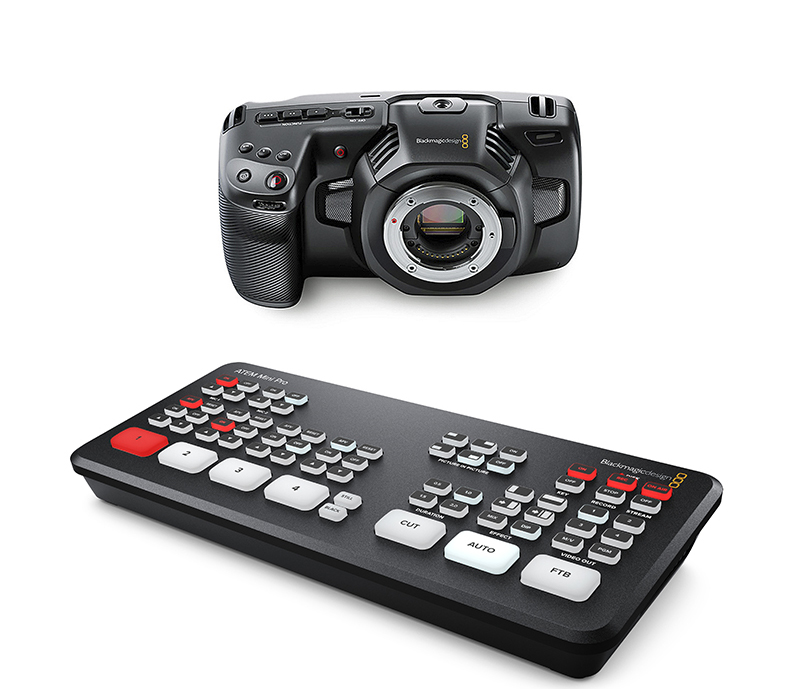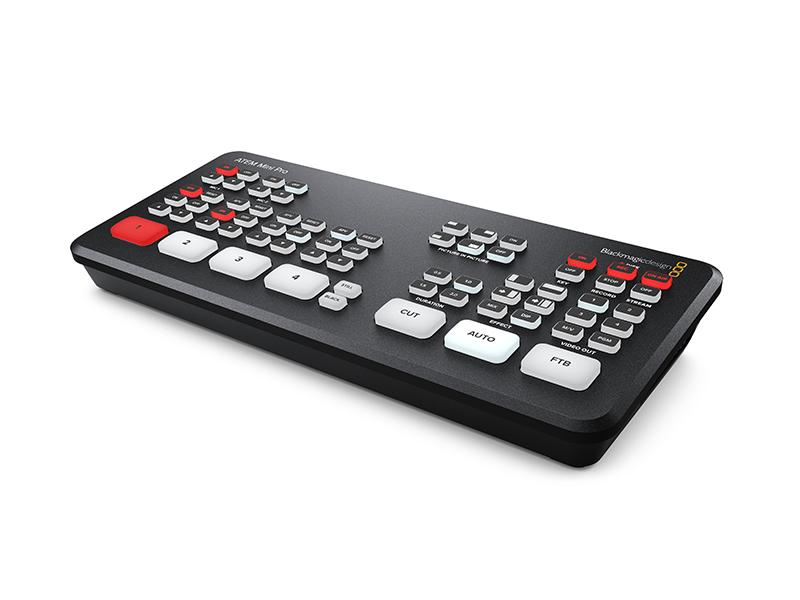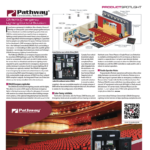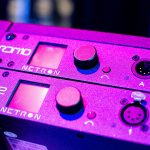
With this month’s Product Spotlight, PLSN reviewer Jeff Gooch checks out a pair of products from Blackmagic Design that promise to enhance your video production prowess without breaking the bank: the Pocket Cinema Camera 4K AND ATEM Mini Pro switcher.

Pocket Cinema Camera 4K
The Blackmagic Design Pocket Cinema Camera 4K is an outstanding camera for the price of $1,295. I say “for the price” because you can easily drop far north of that for a similar rig and not get nearly the piece of kit that BMD offers up.
The Hardware
Both the 4K and 6K models are made of super tough carbon fiber polycarbonate. Conventional thinking would suggest that, with material like this, you’d want to make the camera smaller, but this is not the case with the PCC4K. It’s big — really big for a camera, but I find it refreshing, as more real estate affords more features and accessibility. For being so large, the camera has a pretty good feel in the hand. The physical layout is standard DLSR fare, with the exception of a HUGE screen. The screen is easily my favorite feature. There are 1/4-20 mounts on top and bottom for extra gear — and you’ll need them. A cage and some handles will definitely help when using this camera in a studio setting, although using it straight away on a tripod will work just fine for most folks.
I/O ports are all on the same side and covered by beefy rubberized lids. The important one here is USB-C. You’ll absolutely need to connect some external SSD storage for anything requiring any length of time. Shooting at DCI 4K in Blackmagic RAW (while an excellent codec) will still only get about two hours on a 256gb card. The PCC4K uses SD cards as well as CF storage. Keep in mind, the camera supports HD video standards from plain-vanilla 1080/30 all the way through DCI 4K 60 in ProRes or Blackmagic RAW, so there all kinds of ways to save space and not sacrifice quality. There are three Function buttons on top that are assignable for quick access to things like FPS, Iris, White Balance, ISO, and Shutter. The camera features 13 stops of dynamic range as well as dual native ISO up to a whopping 25,600, which allows for super-low noise images in any lighting conditions.
The PCC4K has an MFT lens mount, so there’s an endless supply of decent lenses to choose from. The other thing I noticed was lens meta-data being preserved when importing footage into Blackmagic’s DaVinci Resolve Studio (included with the camera!) It features a 4/3 size sensor, 13 stops of dynamic range and dual native ISO up to 25,600 for HDR images and ridiculous low-light performance. Audio-wise, there is a single mini XLR input that is switchable from mic (with phantom power) to line. There is also a 3.5mm stereo input that can be used for timecode input. The onboard dual-mic is great, but you have to be a little careful not to bump either one when using the camera hand-held.
About that screen. I reviewed Blackmagic’s Ursa Mini a while back (PLSN, April 2017, plsn.me/Ursa) and the screen was easily the best feature on the camera. This is the case with the Pocket Cinema Camera as well. The menu layout and functions are super easy to navigate and make adjusting the system to your exact preferences quick and painless. When shooting, you can obtain razor-sharp focus and see everything including a histogram, focus and peaking indicators, levels, frame guides, and playback controls. There are a ton of other advantages to this camera — more than I can put down here — but a big one is the Tally light. If you’re hooked to an ATEM switcher, the record light becomes a tally light when that camera is selected. Crazy! Another fave is the Bluetooth camera control as well as control from within an ATEM switching environment. In a simple studio setup, this becomes invaluable for adjusting on the fly. As far as power is concerned, the Pocket Cinema Camera uses standard LP-E6 batteries, and you’ll need a few, as it is a hungry machine. Blackmagic has an add-on Pocket Battery Grip device which affords two extra batteries.
4K not enough for you? There is a 6K version as well if you need more pixels.
There’s a Spartan physical layout on this camera, and its size affords a comfort not shared by similar featured video cameras, or even DSLR’s for that matter. In the digital film world (as with most things), simple is usually better, and I think the Pocket Cinema Camera nails a great balance of advanced quality with an inherent simple-use package. I’d put the Pocket Cinema Camera 4K easily as the best sub-$1,500 video camera on the market right now.

ATEM Mini Pro Switcher
I am a switcher fanatic. I am also an ATEM fan, but when I got a hold of the Mini Pro, I was positively giddy. The ATEM Mini, when introduced, was a sub-$300, 4-input switcher that could literally fit in a large pocket. The Mini Pro is all of that and more.
The ATEM Mini Pro is a 4-input HD switcher with a lot going on under the hood. Before switchers of this type, you had to rely on software workflow, instead of a straight hardware line-cut. And then you had to spend hours in post trying to cut and assemble everything else. No more! The ATEM Mini Pro solves all of that in one small, compact, efficient frame. The biggest advantage, though, is the built-in hardware encoder for streaming.
Around the Deck
The ATEM Mini Pro is small, but it is weighty. It’s small enough for a person to span the deck with one hand to switch, and yet it’s heavy enough to remain positioned even with cables attached when you’re banging away on cameras. The button feel is that of ATEMs of old — with a soft feel, but physically “clicky” enough to have confidence that a stroke was made. Each input has a large, well-lit TAKE button and a sub-panel of function buttons above it. AFV (Audio Follows Video), Reset, On/Off and arrow keys for selection are the choices. There is a small section for PIP effects, quick keys for Auto trans times, Black source, Still source and the streaming area. On the back are four standards-convertible HDMI ports, an HDMI output, two 3.5mm Audio mic inputs, Ethernet and USB-C out.
The primary difference between the Mini Pro and the standard Mini is the ability to live-stream and encode straight out of the box. Simply connecting the Ethernet port to your router not only gets you to a crazy amount of switching capability, but various apps see your ATEM as a webcam input. As with all ATEM switching, the true power comes in using BMD’s software. Yes, buttons and a switcher are great, but the ability to network all of your switchers and utilize multiple users is where the rubber meets the road. Within ATEM’s software control are camera shading/control (when using Blackmagic cameras), a Fairlight audio mixer, a stills/media pool and direct monitoring of stream/record functions. Using the USB-C output allows direct H.264 recording to external disks as well as being recognized as a webcam by apps like YouTube Live, Facebook, OSB, Twitch, Zoom and many others. You can use the HDMI program out to record directly to external recorders like Blackmagic’s HyperDeck at the same time, even using a different codec/format. There is also media player support for fill and key images, which support up to 20 stills in PNG, TGA, BMP, JPEG and TIFF format. The advanced Chroma Key and Downstream linear keyer are impressive features for a switcher of this size, as well as the full complement of DVE effects, including a flying key feature for more advanced switch effects.
The ATEM Mini Pro is truly going to shine in smaller setups — like a professional looking webcast in a home studio, or high quality distance learning in a classroom. But just because it is small doesn’t mean it can’t do big things. The networking aspect alone means remote setups are easy with control in another building or across the city. Use a bonded cell connection and be completely mobile in an instant. You need not sacrifice quality for relative quantity. The real impediment here is cable length. But with HDMI-fiber around $2 per foot (and the 10,000 mini converters we all already own), that limitation won’t be around for long.
For more information, visit www.blackmagicdesign.com


